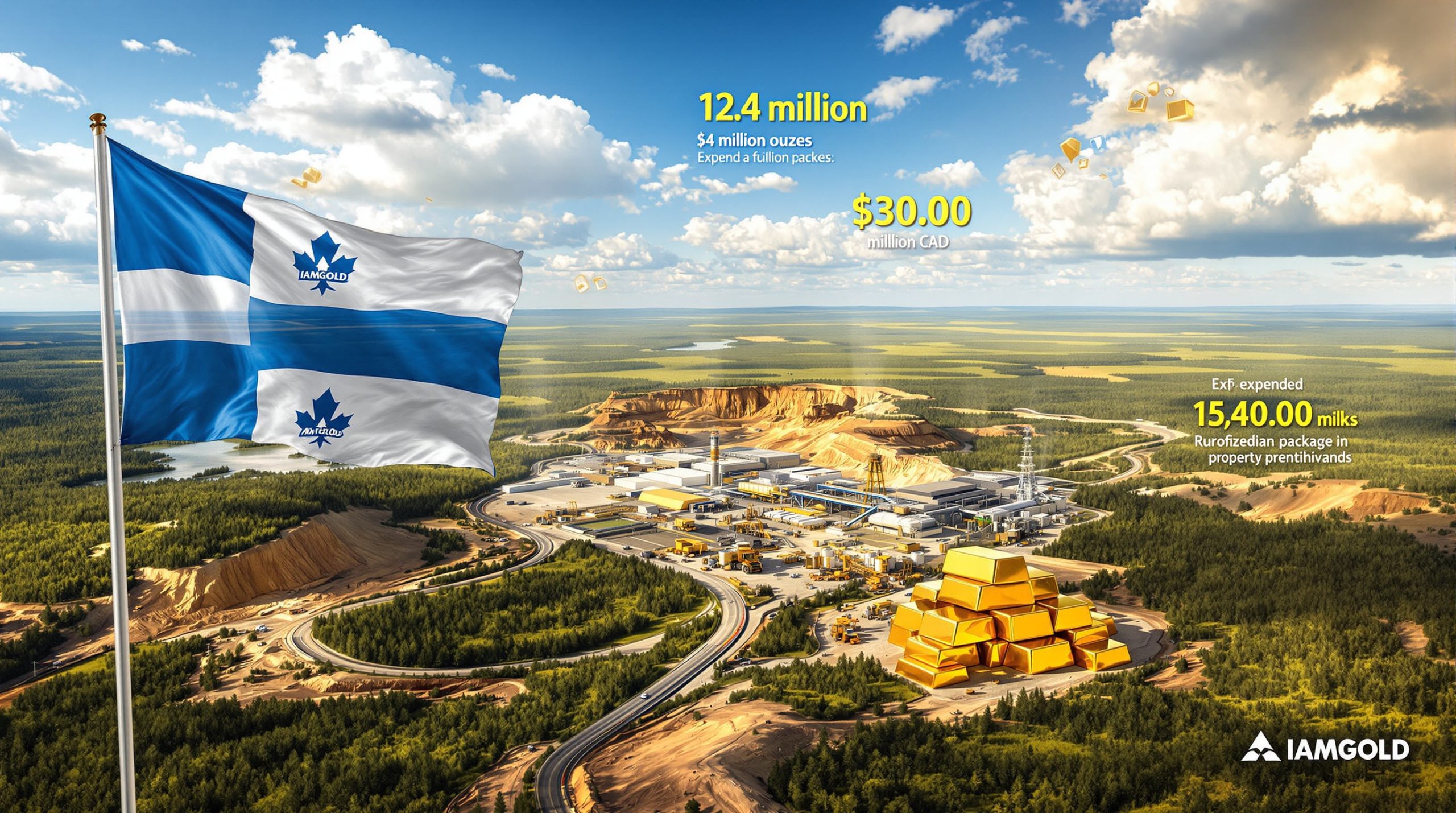Understanding CMOC's Strategic Expansion in the Democratic Republic of Congo
China Molybdenum Co. (CMOC) has announced a transformative expansion of its Kisanfu Mining operations in the Democratic Republic of Congo, representing one of the most significant copper development initiatives currently underway globally. The CMOC to invest in Congo copper mine expansion initiative involves a $1.08 billion investment that will dramatically increase production capacity, positioning the facility to deliver approximately 100,000 metric tons of additional annual copper output by 2027.
The strategic timing of this expansion reflects broader market dynamics affecting global copper supply forecast. With existing operations at the site already demonstrating operational success, CMOC's decision to double down on its Congo investments signals confidence in both the geological potential and the operational framework established through its initial development phase.
Investment Overview:
- Total capital commitment: $1.08 billion
- Additional production capacity: 100,000 metric tons annually
- Project timeline: Phase 2 operational by 2027
- CMOC ownership structure: 71.25% through Hong Kong subsidiary
- Combined facility output post-expansion: 200,000 metric tons annually
The expansion leverages existing infrastructure from Phase 1, which achieved full operational capacity in 2023, creating significant cost efficiencies compared to greenfield developments. This brownfield approach allows CMOC to maximise return on invested capital whilst minimising technical and operational risks typically associated with new mine developments.
How Will This Expansion Transform Global Copper Supply Dynamics?
Addressing Critical Supply Constraints
The global copper market faces mounting supply pressures as production disruptions affect major facilities worldwide. Recent operational suspensions at significant mining operations, including challenges at Indonesia's Grasberg complex, have intensified focus on reliable production sources capable of meeting growing demand from renewable energy infrastructure and electric vehicle manufacturing.
Furthermore, CMOC Group's expansion directly addresses these supply concerns by adding substantial production capacity from a proven operational base. The Democratic Republic of Congo already represents a critical source of global copper supply, and increasing output from established facilities provides market stability during periods of supply uncertainty.
Production Scale and Market Positioning
| Operational Phase | Annual Output | Market Impact |
|---|---|---|
| Pre-expansion | 100,000 tonnes | Established producer |
| Post-Phase 2 | 200,000 tonnes | Major regional supplier |
| Combined CMOC DRC | 700,000+ tonnes | Global top-tier producer |
The doubled production capacity positions KFM among the most significant copper operations in Central Africa. This scale provides operational advantages through economies of scale in processing, transportation, and administrative functions whilst creating substantial employment and economic development opportunities in the region.
Strategic Supply Chain Implications
Unlike single-commodity operations, the KFM facility produces both copper and cobalt, creating natural portfolio diversification within a single operational framework. This dual-metal production model generates enhanced revenue potential whilst providing operational flexibility during periods of price volatility in either commodity market.
The expansion also strengthens China's strategic position in critical mineral supply chains. By maintaining direct ownership and operational control over major production facilities, Chinese companies reduce dependence on market-based procurement whilst securing long-term access to materials essential for domestic manufacturing and technology development initiatives.
What Are the Strategic Advantages of CMOC's Congo Operations?
Brownfield Development Benefits
CMOC's expansion strategy capitalises on existing operational infrastructure, providing significant advantages over competitors developing entirely new mining projects. The brownfield approach offers:
Capital Efficiency Advantages:
- Reduced initial infrastructure investment requirements
- Proven processing technology and operational methodologies
- Established transportation and logistics networks
- Existing regulatory relationships and compliance frameworks
- Demonstrated geological understanding and resource estimation accuracy
The Phase 2 expansion builds upon operational knowledge gained during the initial development and ramp-up phases, allowing for optimised design and implementation strategies that minimise both technical risks and capital requirements.
Integrated Operations Model
CMOC operates multiple facilities within the Democratic Republic of Congo, creating synergies between operations that enhance overall efficiency and profitability. The company's Tenke Fungurume Mining (TFM) facility, where CMOC holds an 80% stake, produces over 450,000 tonnes of copper annually, establishing a regional operational base that supports both facilities.
This integrated approach provides:
- Shared technical expertise and operational best practices
- Consolidated supply chain management and procurement efficiencies
- Enhanced regulatory relationships and government engagement
- Diversified production base reducing facility-specific risks
- Combined infrastructure utilisation optimising transport costs
Geological and Resource Advantages
The Kisanfu deposit demonstrates favourable metallurgical characteristics that support efficient copper extraction and processing. The ore body's geological structure allows for conventional mining methods whilst maintaining competitive production costs relative to global copper operations.
Resource quality metrics indicate consistent grade distribution throughout the deposit, supporting long-term production planning and operational stability. This geological predictability reduces operational uncertainties that can significantly impact mining project economics and investment returns.
How Does This Investment Position CMOC Globally?
Strengthening Market Leadership Position
With combined 2024 production exceeding 650,000 tonnes of copper across its global portfolio, CMOC ranks among the world's top copper producers. The KFM expansion will add approximately 15% additional capacity to the company's total output, solidifying its position whilst reducing per-unit production costs through operational scale advantages.
CMOC Global Production Portfolio:
| Facility | Location | Ownership | Annual Capacity |
|---|---|---|---|
| Tenke Fungurume | DRC | 80% | 450,000+ tonnes |
| Kisanfu (Post-expansion) | DRC | 71.25% | 200,000 tonnes |
| Las Bambas | Peru | 62.5% | 300,000+ tonnes |
This diversified geographical and operational portfolio provides natural hedging against regional political risks, regulatory changes, and operational disruptions whilst maintaining exposure to high-grade, low-cost production opportunities.
China's Resource Security Strategy
The investment exemplifies China's systematic approach to securing critical mineral supplies through direct ownership of upstream production assets. Rather than relying solely on market-based procurement, Chinese companies increasingly prioritise vertical integration strategies that provide supply chain control and price stability.
This approach creates strategic advantages during periods of global supply constraints or geopolitical tensions affecting international commodity markets. Direct operational control provides greater certainty for long-term planning in downstream manufacturing and technology development sectors.
What Risks and Challenges Could Impact Project Success?
Regulatory and Political Environment
The Democratic Republic of Congo's regulatory framework presents both opportunities and challenges for international mining operations. CMOC has navigated previous regulatory complexities, including export restrictions at its TFM facility during 2022-2023 related to royalty payment disputes with the Congolese government.
Key Regulatory Considerations:
- Evolving mining code requirements and taxation structures
- Local content and employment obligation compliance
- Environmental and social governance standard implementation
- Export licensing and international trade regulation changes
- Currency exchange and repatriation policy modifications
The resolution of previous regulatory disputes demonstrates CMOC's capability to work within the existing framework whilst maintaining productive relationships with government authorities and regulatory bodies. Moreover, tariffs impact on copper supply remains a consideration for global operations.
Market Volatility and Commodity Price Risk
Copper markets experience significant price volatility driven by global economic conditions, supply disruptions, and demand fluctuations from major consuming sectors. CMOC acknowledges these risks whilst highlighting several mitigating factors:
"The expansion strengthens the company's position in global markets while acknowledging potential risks from price fluctuations and regional economic uncertainty."
Risk Mitigation Strategies:
- Diversified production portfolio across multiple jurisdictions
- Dual-commodity production reducing single-metal exposure
- Long-term supply agreements providing price stability
- Low-cost production profile maintaining competitiveness
- Established customer relationships in key consuming markets
Infrastructure and Operational Challenges
Large-scale mining operations in Central Africa face ongoing infrastructure limitations that can impact operational efficiency and cost structures. These challenges include transportation network capacity, power generation reliability, and skilled workforce availability.
However, CMOC's established operational presence provides advantages in addressing these challenges through existing relationships with local suppliers, transportation providers, and governmental infrastructure development initiatives. Additionally, mineral exploration trends continue to influence operational strategies across the region.
How Will This Expansion Affect Regional Development?
Employment and Economic Multiplier Effects
The KFM expansion is projected to create thousands of direct employment opportunities whilst generating significant indirect economic activity throughout the region. Mining operations of this scale typically support employment ratios of 3-5 indirect jobs for every direct position created.
Economic Impact Categories:
- Direct mining operations employment
- Transportation and logistics services
- Local supplier and vendor networks
- Community services and infrastructure support
- Skills training and capacity building programs
- Regional business development opportunities
The expansion also contributes to government revenues through taxation, royalty payments, and export duties, providing resources for broader regional development initiatives and public infrastructure investments.
Infrastructure Development Catalysis
Large-scale mining expansions typically drive broader infrastructure improvements that benefit entire regions beyond the immediate operational areas. These developments often include:
- Enhanced road networks improving regional connectivity
- Power generation and distribution system upgrades
- Water treatment and management infrastructure
- Communications and technology infrastructure expansion
- Healthcare and educational facility development
- Financial services and banking infrastructure
Such infrastructure improvements create long-term economic development opportunities that extend far beyond the operational lifespan of individual mining projects, establishing foundations for sustained regional growth.
What Does This Mean for Global Copper Market Outlook?
Supply Security for Energy Transition
The KFM expansion addresses critical supply requirements as global copper demand accelerates due to renewable energy deployment, electric vehicle adoption, and electrical grid modernisation initiatives. Copper's essential role in electrical infrastructure makes securing reliable production sources increasingly strategic for economic development and energy transition goals.
Key Demand Drivers:
- Wind and solar power generation infrastructure
- Electric vehicle manufacturing expansion
- Grid modernisation and energy storage systems
- Industrial electrification initiatives
- Telecommunications and data centre development
The additional 100,000 tonnes of annual production capacity represents meaningful supply additions in a market where new major projects face increasingly long development timelines and complex regulatory approval processes. Furthermore, copper price predictions suggest continued market tightening.
Competitive Positioning Analysis
| Major Copper Projects | Location | Investment | Capacity | Timeline |
|---|---|---|---|---|
| CMOC KFM Phase 2 | DRC | $1.08B | 100,000 tonnes | 2027 |
| Southern Copper Tía María | Peru | $1.8B | 120,000 tonnes | Approved 2025 |
| Various Expansion Projects | Global | Variable | Mixed | 2025-2030 |
CMOC's expansion timeline positions the company to capture market opportunities during a period when few new major projects are scheduled to reach production. This timing advantage could provide significant competitive benefits if copper markets tighten due to supply constraints or accelerating demand growth.
Long-term Market Structure Implications
The success of brownfield expansions like KFM could influence industry approaches to capacity growth, potentially favouring expansion of proven operations over high-risk greenfield developments. This trend could reshape global copper supply patterns whilst affecting investment strategies throughout the mining sector.
Additionally, the concentration of major new supply additions in politically complex regions like the Democratic Republic of Congo raises questions about supply chain resilience and the strategic importance of geographical diversification in global copper production.
Investment Implications and Strategic Value Creation
Capital Efficiency and Return Optimisation
CMOC's expansion demonstrates how established operators can create substantial value through systematic capacity growth rather than pursuing high-risk exploration ventures or greenfield developments. This approach offers several investor advantages:
Value Creation Mechanisms:
- Predictable production growth with established timelines
- Reduced geological and technical development risks
- Leveraged infrastructure investments maximising capital efficiency
- Established market relationships and sales agreements
- Operational expertise reducing execution uncertainties
The brownfield expansion model allows for more accurate cost estimation and production forecasting compared to entirely new developments, potentially supporting more reliable investment returns and reduced project financing costs.
Broader Sector Development Implications
The success of large-scale expansions like KFM could encourage similar investments across the copper sector, potentially alleviating long-term supply constraints whilst creating opportunities for equipment suppliers, engineering firms, and logistics providers supporting major mining operations.
This trend could also influence mining sector investment patterns, with capital potentially flowing toward proven operators with expansion potential rather than early-stage exploration companies or unproven development projects. Consequently, copper and uranium investments may shift focus towards established operators.
Strategic Portfolio Considerations
For investors seeking exposure to copper market growth, CMOC's expansion represents exposure to several key themes:
- China's strategic resource security initiatives
- African mining sector development and growth
- Energy transition commodity demand acceleration
- Brownfield expansion versus greenfield development strategies
- Operational scale advantages in global commodity markets
Positioning for Future Copper Market Leadership
CMOC's $1.08 billion investment in the Congo copper mine expansion represents a calculated strategic investment designed to strengthen the company's position in global copper markets whilst addressing critical supply requirements for the ongoing energy transition. By leveraging existing operational infrastructure and demonstrated expertise, the company has positioned itself to deliver significant production growth with manageable risk profiles.
The project's ultimate success will depend on CMOC's continued ability to navigate the Democratic Republic of Congo's complex regulatory environment whilst maintaining operational excellence and productive community relationships. As global copper demand continues accelerating driven by renewable energy deployment and electric vehicle adoption, expansions like KFM will play increasingly vital roles in meeting supply requirements.
The strategic implications extend beyond individual company performance to influence broader industry patterns, potentially encouraging similar brownfield expansion strategies whilst highlighting the importance of operational expertise and regional relationships in complex mining jurisdictions. Furthermore, critical mineral investments of this scale demonstrate China's commitment to securing essential resources for its economic development.
Disclaimer: This analysis is based on publicly available information and should not be considered investment advice. Copper markets and mining operations involve significant risks including commodity price volatility, regulatory changes, and operational uncertainties. Investors should conduct their own due diligence and consult qualified professionals before making investment decisions.
Ready to Capitalise on the Next Major Copper Discovery?
CMOC's massive Congo expansion demonstrates how transformative mineral discoveries can reshape markets and create substantial investment opportunities. Discovery Alert's proprietary Discovery IQ model delivers real-time alerts on significant ASX mineral discoveries, empowering subscribers to identify actionable opportunities like major copper finds ahead of the broader market and begin your 30-day free trial today to secure your market-leading advantage.




